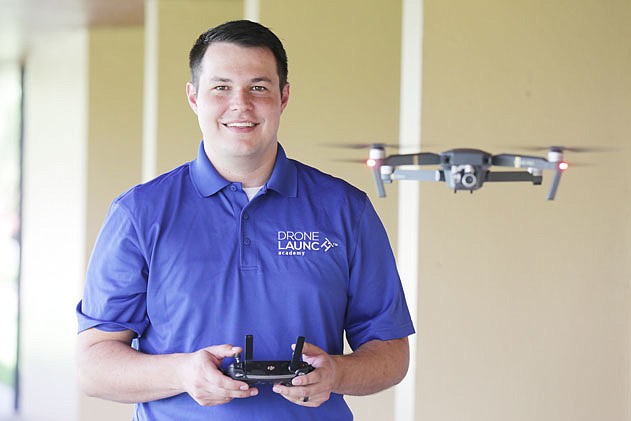By John Haughey | Contributing Writer
Farmers use them to draft 3-D soil analysis maps. Surveyors use them to plot laser-perfect measurements. Insurance adjusters? They use them to re-create accident scenes. Realtors get in on the action to provide virtual tours. Roofers can use them to assess damage without climbing a ladder.
What is this all-purpose tool? Drones, of course.
“People are coming up with new uses for drones all the time. There is an infinite number of possibilities,” said David Young, founder and chief instructor of Lakeland-based Drone Launch Academy, which offers an online curriculum to pass the Federal Aviation Authority's Unmanned Aircraft Exam — a requirement to receive a Remote Pilot Certificate.
Young, a licensed private pilot and a FAA-certified advanced ground instructor, had little interest in drones until three years ago, when he purchased a “very small,” inexpensive Syma. He instantly realized commercial applications would soon boom.
“The technology is getting better and they're becoming affordable: $500 for a drone that can fly a half mile with a good camera,” he says. “That's not out of reach for a lot of people.”
Young, 29, a Lakeland High School and Florida State graduate, has a master's in finance from Johns Hopkins University and is a CPA. His financial analytics firm, DCY Consulting, includes Google among its Fortune 50 clients.
But intrigued by drones, his entrepreneurial instincts were aroused. For one, the FAA estimated in 2016 that Americans own more than 600,000 small unmanned aircraft systems, drones weighing less than 55 pounds. And, according to projections from research firm Global Industry Analysts, the American small unmanned drone-as-a-service industry will generate $1.8 billion annually by 2020.
Thought Young: “There is an opportunity in this.”
He was right. The FAA provided that opportunity on Aug. 31, 2016, when it issued its first set of comprehensive rules regulating commercial small unmanned drone use. Those rules replaced a hodgepodge of state laws, including 168 passed in 45 states in 2015 alone. It imposed standardized requirements for commercial Remote Pilot Certificates, creating demand for online manuals, video classes and study materials.
In October 2016, Young founded Drone Launch Academy after attending a Washington, D.C., conference where he met Andrew Zimmitti, an attorney specializing in drone law, and retired Air Force Col. Don Berchoff, a former Air Force One meteorologist for President George H.W. Bush and CEO of TruWeather Solutions, a weather service for drone operators.
Berchoff and Zimmitti liked what they heard about Young's fledgling drone academy —and Young himself. Berchoff is now a weather instructor at the Drone Launch Academy, while Zimmitti handles legal and regulation instruction. “I found David to be a smart guy, motivated, with initiative and ethics,” Berchoff says. “We started talking about how we can help each other. Once he told me what he was doing, I understood the importance of certification and training.”
Retired Air Force Maj. Nathan Green, also a meteorologist, soon joined Drone Launch Academy as the curriculum's chief author. Within a year, it had 1,500 enrolled students. “We're looking to grow more,” Young says.
There should be ample opportunity for that. The FAA says it issued nearly 28,000 small unmanned drone (sUAS) Remote Pilot Certificates in the last three months of 2016. By June 1, more than 60,000 people nationwide were FAA-certified commercial drone pilots, the agency adds.
Young predicts “exponential” drone-as-a-service growth, noting the flying machines are already common tools among many occupations, such as electricians, power line workers and firefighters, to “avoid situations where, normally, someone would have put themselves in an unsafe position.”
Drones are also money-savers, Berchoff says. “To fly a helicopter 15, 20 miles along a pipeline to find a gas leak would cost $2,500 an hour,” Berchoff says. “A drone? One-tenth of that.”
For Young, that means lots of runway. “A lot of people are starting drone service businesses,” Young said. “This is definitely not going away. I want to be on the front end of this. I'm going to keep pivoting, keep updating and stay current.”






